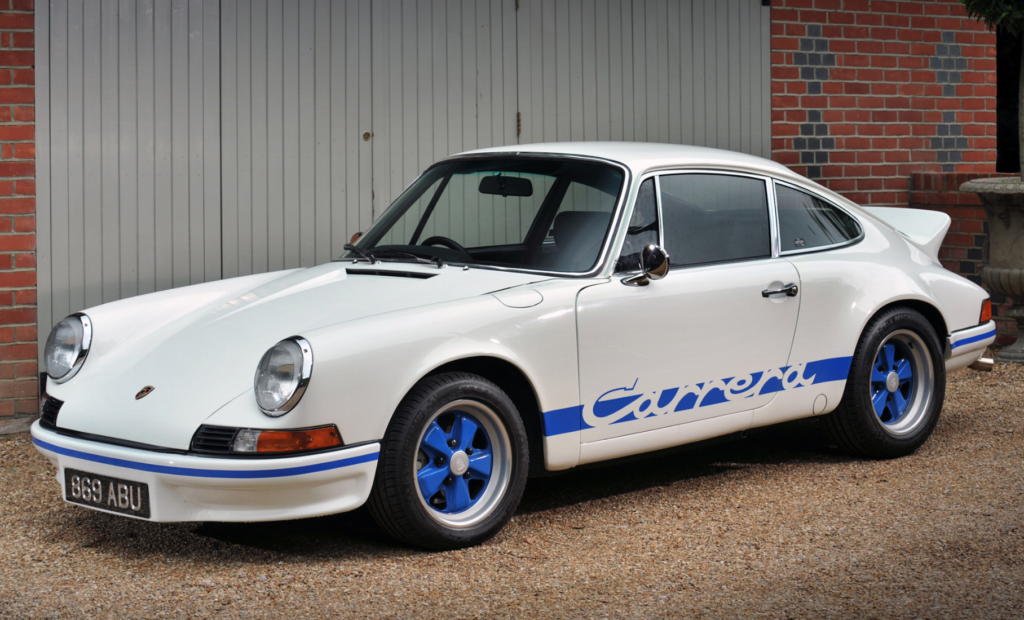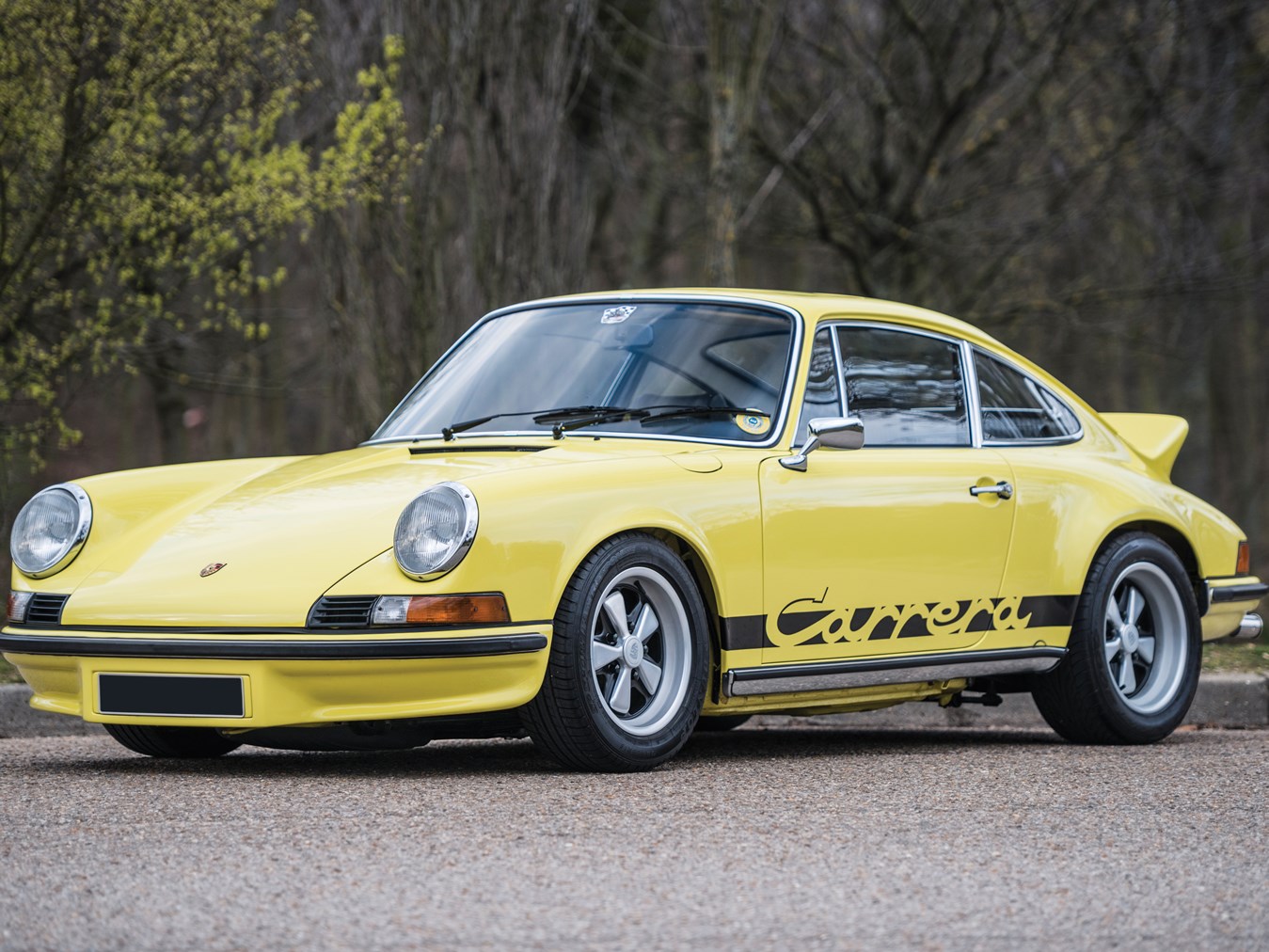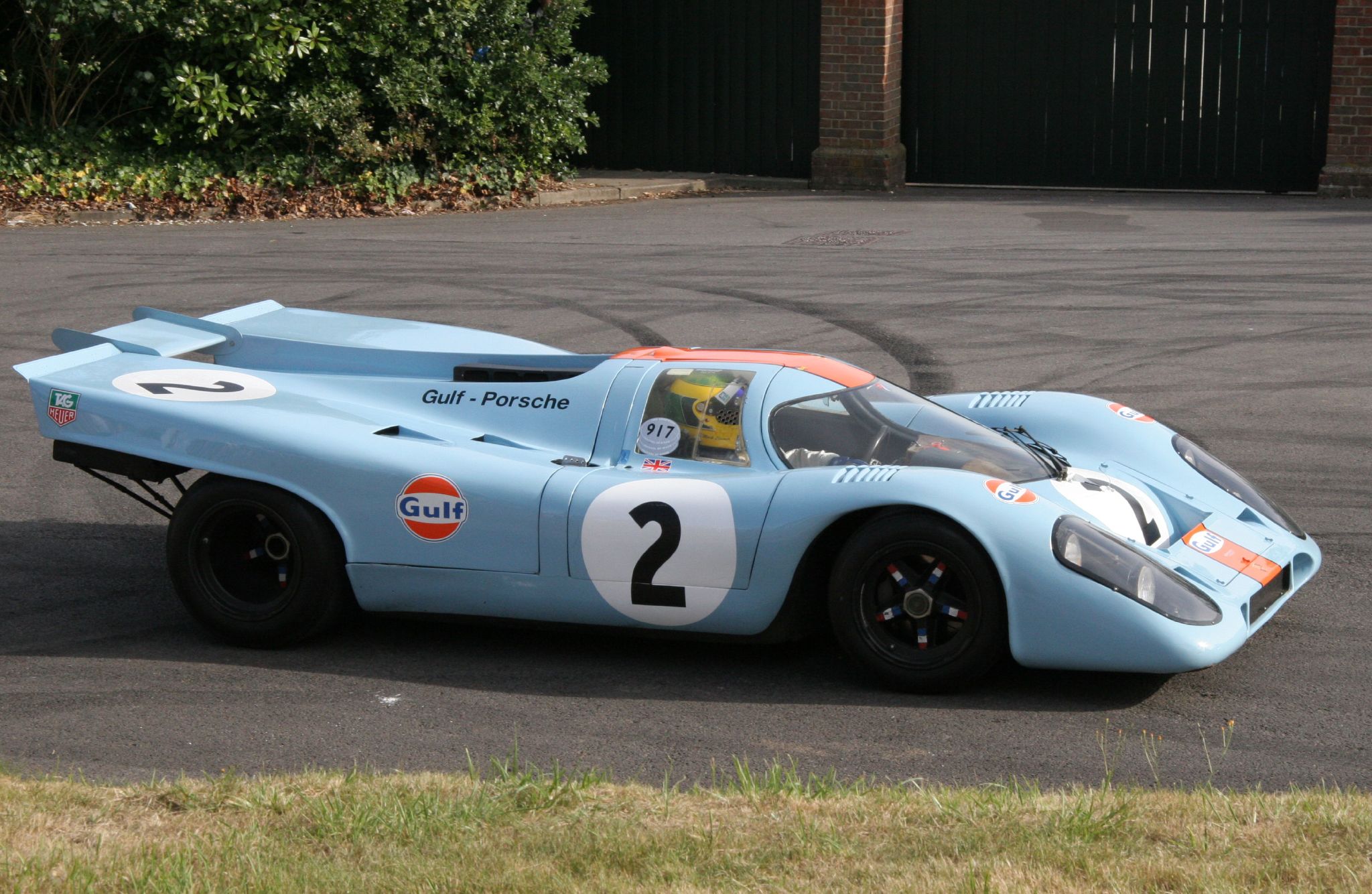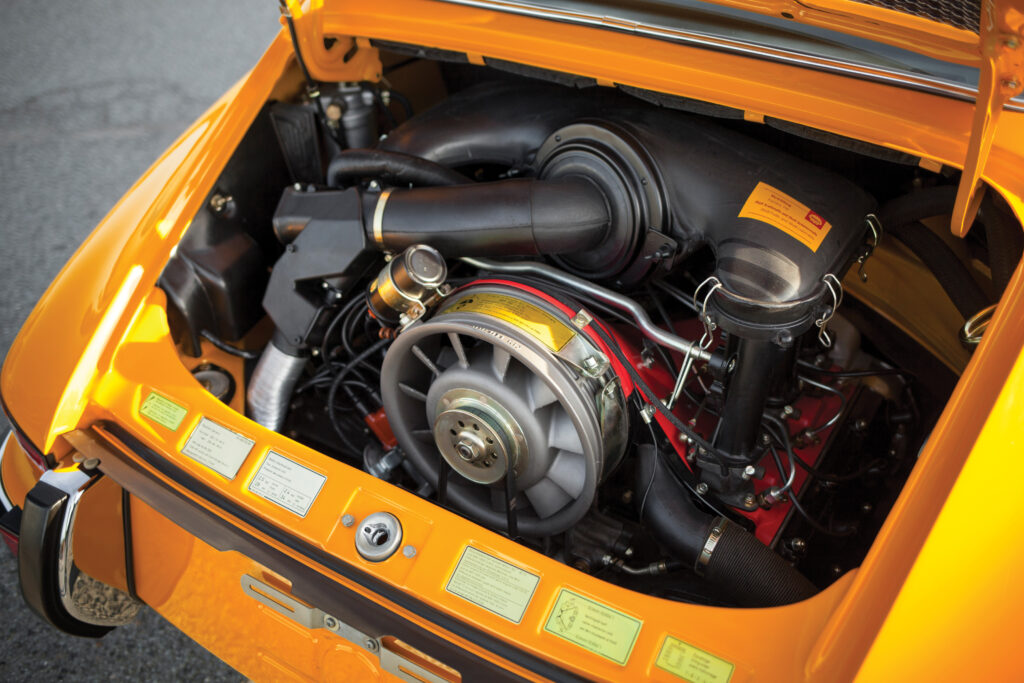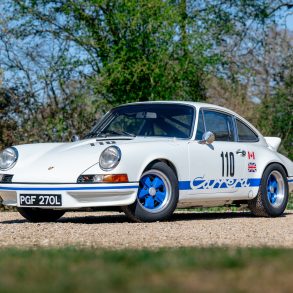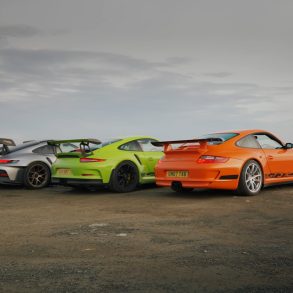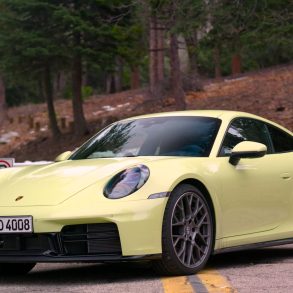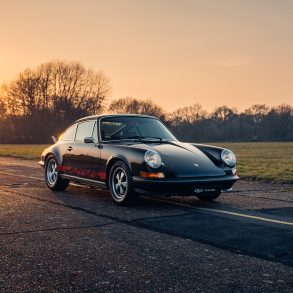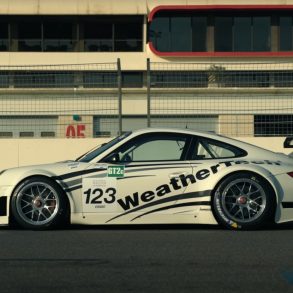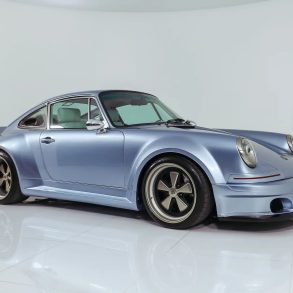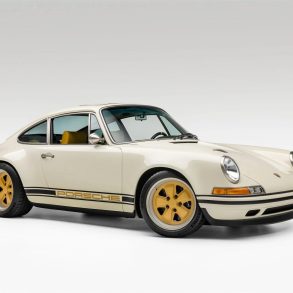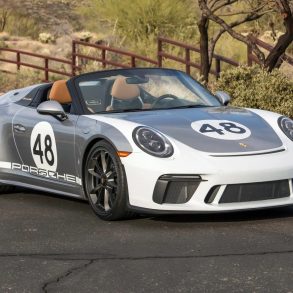Porsche 911 Carrera RS 2.7
1973 Porsche 911 Carrera RS 2.7
Engine: 2,687 cc, air-cooled horizontally flat six
Production dates: November 1972 – July 1973
Transmission: Five-speed manual
Power: 210.0 bhp @ 6,300 rpm
Torque: 188.0 ft lbs @ 5,100 rpm
Weight: 975 kg (2149 lbs)
0-60 mph: 5.6 sec (est)
Top Speed: 150 mph (est)
Introduction
Originally published on our sister site, Supercars.net
The Carrera RS debuted in October 1972 at the Paris Motor Show, and was the top first generation 911 and one of the best road cars of all time. It was the fastest production 911 and a solid race winner. Some feel it is still the best 911 ever built.
The early 1970s marked the culmination of Porsche’s dominance in the prototype era and the start of a GT racing program based on the ever-successful 911. A decade after the 911’s debut, the public was presented a homologation special that foreshadowed a legendary line of racing Porsches – the Carrera 2.7 RS. Fitted with flared wheel arches, a distinctive ducktail spoiler, and a highly tuned flat-six engine, the brilliant Carrera 2.7 RS is the model against which all subsequent high-performance 911s are judged. The 2.7 RS road car was the mechanism for homologating the parts needed for racing.
The 210 bhp 2.7 liter engine, benefitting from the experience gained with the 917 racing program, elevated the 911 into the 2500-3000 cc class (RSR racing versions were initially 2.8 liters, and later 3.0 liters) and the possibility of mixing it with heavyweight opposition such as Ferrari Daytonas and DeTomaso Panteras. The ducktail rear spoiler is the first proper wing on a 911; the widened wheel arches allowed more rubber to come in contact with the road, and Porsche put the car on a diet (lightweight panels, stripped interior), reducing the weight to as little as 975 kg. There were several variants and options available to buyers.
A Road / Race Car
The Carrera RS 2.7 was conceived as a 911-derived race car and was the first production street/race 911 widely offered to the public. The company’s philosophy was that Porsche’s (except for pure competition models) should be used for daily transportation.
Porsche built the RS on top of the 911S 2.4, the fastest standard Porsche 911 you could buy at the time. The RS got a larger, more powerful 911S-based flat-six engine and was extensively lightened. The RS looked nearly the same as the 911S, but had a “chin spoiler” under the front bumper and rear fender bulges as well as the now famous “ducktail” spoiler. There also was “Carrera” script across each door in a contrasting color that matched the car’s Fuchs wheels.
The 2.7 RS delivers performance that’s impressive even by modern standards, so it’s no surprise that it inspired cars like the GT2 RS and GT3 RS. The 2.7 RS is arguably the Porsche that set in motion the 911’s progression from great road car to one of the finest track machines of all-time. The total package was a fun and street-able 911 with real racing chops that set the template for how Porsche builds race-road special models that still holds today.
The 2.7 RS initially couldn’t legally be used in the U.S for anything but racing. It had no emissions equipment because it was made strictly as a European road-race car. Fortunately, the EPA eventually relaxed emissions standards enough for older cars to let Porsche 2.7 RS owners legally drive it on U.S roads.
The Carrera name hadn’t been used on road-race Porsches for a decade and it was new to the 1970s younger generation of Porsche fans. The name was revered because a Porsche had successfully competed in the famous Carrera Panamericana road race in Mexico in 1953 and 1954. The letters “RS” stood for “Rennsport” (racing sport) and designated a competition Porsche. The “2.7” stood for the 2.7 liter displacement of the RS engine.
Thank The Porsche 917
The sole purpose of the 2.7 RS was to homologate the 911 for competition so that Porsche could take the fight to the Group 4’s top dogs of the era with its 2.8 RSR race car. With its powerful yet light mechanically injected flat six and lighter weight, the RSRs became legends almost overnight. To understand how we got to this point, we need to go back to the sheer dominance of the 917 in prototype endurance racing.
The Porsche’s 917 was basically outlawed from international competition after dominating endurance car racing from 1969 to 1971. It set so many new speed and lap time records that the FIA changed the homologation rules to limit displacement to 3.0 liters for Group 5 in 1972, citing safety reasons for the decision. The FIA knew fully well it was deliberately banning the Porsche 917 from sports prototype racing for the 1972 season, but it didn’t see how that decision would drive Porsche to double down on the GT racing scene. Porsche moved away from the 917 (except for Can-Am racing in North America) and onto a program committed to developing its 911 road car into a serious track competitor.
The target was Group 4 (Special Gran Turismo) in European GT racing. Porsche already had a presence in the production GT class, in the form of many privately entered 911s. The 2.4S, which in 1972 was the sportiest version of the 911, was beginning to suffer at the hands of the bigger Ferrari Daytonas and De Tomaso Panteras. Porsche needed to build 500 identical 911 specials to homologate a new car into the Group 4 category, a class that allowed a bigger engine and greater flexibility in a weight reduction and wheel size. And so, under and racing chief Norbert Singer, Porsche looked at ways to turn the 911 into a racing car.
It turns out that a displacement of just under 3.0 liters turned out to be perfect for powering the relatively small Porsche 911.
The Engine
The 911’s engine was designed as a 2.0 liter. Porsche had already increased the size of the engine for the 2.4S but a capacity of 2.4 liters was seen as the limit. Developing the engine beyond 2500cc was much more challenging for Porsche but was crucial if the 911 was to be entered into the 3.0 liter.
While the 2.7 RS engine was closely related to that in the 2.4S, the upgrades were substantial. Instead of using a (relatively) thick cast iron liner, the 917’s flat 12 had used a nickel carbide, called Nikasil (which was also low-friction) and Porsche used the same approach here. The problem was that the cylinder walls dangerously thin, so Porsche used an electrolytic deposit system that put the Nikasil material directly onto the aluminum cylinder bores in a layer just a few hundredths of a millimeter thick. This allowed a bore increase to 90mm, increasing the capacity to 2687cc, while retaining a thick aluminum cylinder wall for strength.
The larger bores led to the increased capacity needed and a much beefier, flatter torque curve. Overall, the 2.7 RS’s air-cooled flat six engine boosted power from 193 hp to 210 hp at 6500 rpm. Torque was raised from 159 lb/ft to 188 lb/ft at 5200 rpm.
Weight Loss & Race Prep
Reducing weight to make the most of the 2.7 liter engine’s extra grunt was a priority for Porsche. Porsche had developed a limited edition lightweight car before, the rare 1967 911 R. With perspex windows and fiberglass panels, it weighed just over 1,763 lbs, and only 20 were ever produced. This time things were different because Porsche had to build and sell 500 cars to satisfy homologation rules. Porsche had to sell its new lightweight and stripped out car in the showroom and the idea of plastic windows and doors made the marketing department freak out.
The 911S was the base for the 2.7 RS. Porsche stripped the interior and used special thin glass, light-gauge panels on unstressed body panels and fiberglass bumpers. The bonnet, roof and wings were formed from thinner gauge steel that was 0.08 mm thinner than production standard.
Not all changes were about losing weight. The RS body would also be modified to accommodate wider wheels flaring the rear three quarters 50mm. The racing department wanted to use 11 inch wheels on the track and the racing rules dictated that arches could slightly flared arches. To tame the 911’s high-speed aerodynamic deficiencies, the team created the ducktail rear spoiler. The signature RS ducktail engine cover was made from fiberglass.
There was no weight-adding sound insulation or rear seat, and rubber mats replaced heavier carpeting. Thin front bucket seats had almost no padding. Door panels were flat and plain, with a pull cord instead of an inside door handle. There was no clock or even a passenger side sun visor. There also was no undercoating, doorsill trim, glove compartment lid, coat hooks or springs to counterbalance the front trunk cover.
Specs & Performance
The car was amazingly responsive, with its quick-revving engine, powerful brakes and light, almost telepathic, steering. The race-tuned suspension and wider tires gave a rough ride at low speeds, but it smoothed out at high speeds. The car performed so well largely because it was extremely light at 1,985 pounds and it was coupled to that torquey and more powerful engine. The RS was fast, even by today’s standards. It did 0-60 mph in 5.6 seconds and hit 100 mph in just 12.8 seconds. Top speed was around 150 mph.
That peak torque arrives at a high 5100rpm, but it’s at 4500rpm that the engine’s note takes on the famous wail and the thrust really starts to build. It revs and revs, it and you enjoying every second, each adjustment precisely controllable as the gearbox lets you perform super-fast shifts between the upper ratios in a way you might not have quite expected. The whole thing — thrust, pointability, adhesion, soundtrack – is utterly enthralling, made all the better by the Pirellis, which filter out road harshness and make the RS once again into the civilized tourer that is the other part of its personality.
| model | 1973 Porsche 911 Carrera RS 2.7 |
| type | Series Production Car |
| built at | Stuttgart, Germany |
| production | 200 |
| engine | Air-Cooled Flat 6 w/Dry Sump Lubrication |
| position | Rear, Longitudinal |
| aspiration | Natural |
| valvetrain | SOHC |
| fuel feed | Bosch Mechanical Fuel Injection. |
| displacement | 2687 cc / 164.0 in³ |
| bore | 90 mm / 3.54 in |
| stroke | 70.4 mm / 2.77 in |
| compression | 8.5:1 |
| power | 156.6 kw / 210.0 bhp @ 6300 rpm |
| specific output | 78.15 bhp per litre |
| bhp/weight | 233.33 bhp per tonne |
| torque | 254.89 nm / 188 ft lbs @ 5100 rpm |
| body / frame | Unit Steel, Fiberglass Decklid |
| front tires | 185/70VR-15 |
| rear tires | 215/70VR-15 |
| front brakes | Radially Vented & Axially Drilled Discs |
| rear brakes | Radially Vented & Axially Drilled Discs |
| front wheels | F 38.1 x 15.2 cm / 15.0 x 6 in |
| rear wheels | R 38.1 x 17.8 cm / 15.0 x 7 in |
| steering | Rack & Pinion |
| f suspension | Transverse Control Arms w/Torsion Bars, Anti-Roll Bar, Bilstein Shock Absorbers |
| r suspension | Trailing Arms w/Torsion Bars, Anti-Roll Bar, Bilstein Shock Absorbers |
| curb weight | 900 kg / 1985 lbs |
| wheelbase | 2271 mm / 89.4 in |
| front track | 1443 mm / 56.8 in |
| rear track | 1473 mm / 58.0 in |
| length | 4147 mm / 163.3 in |
| width | 1778 mm / 70.0 in |
| height | 1321 mm / 52.0 in |
| transmission | 5-Speed Manual |
| gear ratios | 3.18:1, 1.83:1, 1.26:1, 0.925:1, 0.724:1 |
| final drive | 4.43:1 |
| fuel capacity | 85 liters or 22.44 gal. |
| 0 – 60 mph | 5.6 seconds |
| 0 – 100 mph | 12.8 seconds |
| top speed | ~150 mph |
Production & Pricing
Porsche needed to build 500 2.7 RS cars to qualify it for the Group 4 Special GT race category.
As the marketing and sales departments prepared for the 2.7 RS to be shown at the Paris Auto Show in October 1972, it is no secret that many of them thought that the car would be a failure. The marketing and sales teams were very concerned about the prospect of selling 500 fully stripped-out road cars, especially considering it couldn’t be sold as a road car in the United States which was Porsche’s largest market.
Calling it the 2.7 S didn’t exactly trumpet the new arrival, so a new name was created — the ‘RennSport’ or ‘motor sport’. And, applying a kind of belt-and-braces approach to badging, they also brought back a historic Carrera 356 name, to be applied to a 911 for the first time. And so the car became the Carrera 2.7 RS.
The price for the basic stripped RS was the equivalent of $11,785 in Germany, only a few thousand dollars more than a 2.4 liter 911S. To make its sales department less anxious, Porsche offered the RS with an $893 “Touring Package” that gave the 2.7 RS the upholstered and trimmed interior found in the 911S along with heavier steel rear bumpers and guards. The RS with the package was Porsche dealer option because 500 RS models had to leave the production line in stripped form. Many RS buyers in Europe ordered the package because they wanted the fastest Porsche road car, but not in stripped form.
Porsche salesmen worked hard in September, 1972, to get RS orders from Porsche dealers and distributors, who also were wary of the car. Moreover, Porsche management members had to take an RS.
The RS had a good sales start with 51 orders taken the 1972 Paris Auto Show itself. Buzz began to build and the entire run of 500 cars was sold out a week after it closed. With orders holding up, Porsche made a second series of RS models over the winter and increased the price by $308.
The 1,000th RS was finished on April 9, 1973. Crossing 1,000 units allowed Porsche reclassify the car for the Group 3 Grand Touring race category. Porsche then pushed the envelope and built 55 even faster, more-special “RSR” models specifically for racing. They cost an additional $8,940.
A total of 1580 2.7 RS cars were built. The first 17 examples off the line were badged RS H (for Homologation); 200 Lightweight Sports (M471) were made; 1308 of 115kg heavier Touring (M491) were produced; 55 RSR racing cars too.
Four Variants
Most people think there were two versions of the RS, the RS Lightweight and RS Touring. In fact, there were four different versions. There was the homologation RSH model that started it all. Then there were three dealer conversions on offer too. The M471 package catered to those who had a tolerance for minimum comfort. Two-hundred customers bought this RS Lightweight package (also known as the ‘Sport’ version) which today is often called the RS Light. 1,308 customers chose the M472 package, which equipped the RS more like a 911S – adding some creature comforts – which was known as the RS Touring models. 55 customers opted to add the M491 package, which added a larger flat six and other race spec options.
- RSH – Homologation – 17 units
- RS Lightweight – M471 – 200 units
- RS Touring – M472 – 1308 units
- RSR – M491 – 55 units
RSH (‘Homologation’)
The starting point was the car Porsche built to qualify for racing — 500 identical cars, which were checked off the production line and weighed to satisfy the sport’s governing body. However, once they’d been accounted for, they could then be modified and sold on through the dealer network. Good job, as no one would want to drive a standard RSH, which was stripped to the point of being silly – narrow tires, no trim around the rear windows, no clock, hardly any underseal, not even a badge on the bonnet. This exceptionally rare H versions had black Carrera decals.
2.7 RS Lightweight (M471)
The RS ‘Sport’ or ‘Lightweight’ (conversion M471) took an RSH and added bigger wheels, carpet in the luggage compartment and a better passenger seat.
The carpet is thin felt overlaid with rubber mats, the glass is thinner too, and you hear every granule of grit flicking into the arches or tinkling along the floorpan. There’s no radio. One sun visor. No armrests. A blank circle of plastic sits in” place of a clock. To open the door, tug on a thin length of leather; to close it, pull on a simple plastic handle. The low-back Recaro bucket seats are thinly padded lightweight items too.
For the first series of Lightweights, the Porsche crest was a weight-saving sticker instead of a metal badge. On the rear decklid, simple rubber hooks took the place of a metal catch and cable.
What all Lightweights lack, compared to Touring RSs, are items like front bumper trim and decorative chrome strips that run the length of the sill beneath the Carrera script.
When you drive a 2.7 RS Lightweight, it’s obvious that the car was built to be a race car. It responds to steering inputs immediately and seems to anticipate what you want it to do.
Learn more about the RS Lightweight (Sport)
2.7 RS Touring (M472)
The Lightweight was still too raw for many, and with the marketing department scared they could not sell such an extremely sparse car, Porsche also decided to offer the RS Touring (conversion M472). The Touring offered 2.4 S-style comfort in the same lightweight body, with normal door furniture, carpets, dials, switches and back seats. It is a more friendly road car
The Touring model is 100kg (220 lbs) heavier than a Lightweight as a result of this added equipment. It is all additional weight contributed by the sport seats, sunroof, and power windows. But it is the RS most buyers opted for due that comfortable interior and optional 7 and 8X15 inch Fuchs wheels.
In terms of driving, the Touring is similar, but just a bit more civilized and refined. The RS Touring ride is slightly softer and thus more comfortable. Creature comforts such as more comfortable seats, power windows, proper door handles, a sunroof, and a passenger-side sun visor all add up to it being more livable daily. The additional undercoating also makes the Touring easier on the ears as well.
Learn more about the RS Touring
2.8 RSR (M491)
Aimed squarely at the FIA’s Group 4 category for Special Grand Touring Cars, Porsche built this all-out racing model based on the Carrera 2.7 RS, incorporating every conceivable improvement allowed by the rule book. The result was the 2.8 RSR, a thoroughbred 911 developed strictly for competition use. It was meaningfully more expensive than both the Lightweight and Touring packaged cars.
It was soon evident that the RSR was easily worth the extra money for privateers looking to race. In its first season, the RSR won the Targa Florio, the 24 Hours of Daytona and the 12 Hours of Sebring, earning it the World Manufacturers and IMSA Divers championships. It went on to win hundreds more races.
Carrera 2.7 MFI
In 1974 Porsche offered a high performance fuel injected Carrera specifically for the European market. These were close to 2.7 RS specification and are often referred to as the 2.7 or Euro Carrera.
Driving Impressions
The RS is the ultimate 911 and is special because of the way it drives. Sure it is rare and expensive, but it is the driving experience that elevates the 2.7 RS to icon status. The sound, the acceleration, the free-revving engine, the feel through the steering and chassis, the cornering poise, the wieldy dimensions, the look and smell of the thing. It is engaging, fun and it just sucks you in. Sure, 210 bhp and 188 lb/ft of torque doesn’t sound like much today but remember the RS Sport weighs only 900kg so that power is more than enough.
It is genuinely fast, in both outright acceleration and point-to-point pace. It hits 0-60mph in 5.5 seconds, 0 – 100 mph in around 10 seconds and tops out at 150 mph. It is small and narrow with deep windows and slim pillars, so there’s road to spare and you can see it all, it feels faster and the speed is more encompassing than in today’s models. You can do 100 mph in a McLaren 720S and not even blink an eye. Doing 60 mph in the 2.7 RS it feels like 100 mph and you are enthralled by the experience. Too many modern cars of great pace slip up here; the 911 RS 2.7 is more usable and enjoyable than any of them.
It’s such an easy car to drive fast too. The rear engine and the plentiful high-revs torque simply make this a car steerable on the throttle. The sound is unmistakable – a deep bass driven yowl overlapped with fast-paced tapping and the rush of accelerated air. The higher the RPM, the better it sounds.
Blasting around roads from apex to apex, the benefits of lightening this Porsche show in every attribute. The ride is firm and you can feel the same road imperfections through the seat as you sense through the steering. The steering is light but not especially quick. The feel through it just perfect. It tugs here and there so you can feel every bump and change in the road. Turn in and the steering weights up as the tires grip, but lightens as soon as I aim for the next corner. It is an early seventies car so if you carry too much speed the nose pushed wide, but in moderately fast road driving it is hard to get the back to step out unless you are being stupid. The non-servo brakes are communicative, with a firm bite and solid stopping performance. The Bilstein dampers control body movements impeccably. Whether in compression or rebound, the RS maintains a rock-solid attitude at all times, all four tires working together to give me the confidence to push harder.
Differences between the Lightweight and Touring variants are a direct reflection of the philosophy of each car. In the Lightweight (Sport) version you get the full unmuffled experience too because of the lack of sound deadening. Everything is louder, more pronounced and more physical. The steering on the Touring model feels just a bit heavier, but that doesn’t mean it can be faulted as a bad-handling car. Where the Lightweight has a raw feeling, the Touring feels much more refined – which was Porsche’s intention. The differences in comfort, nimbleness, acceleration, and intake noise are what separate the two. The Lightweight is pure performance, a street-legal race car that is faster than the Touring.
Buyers Guide
According to research from the Discovery Channel, the Carrera 2.7 RS is the quickest appreciating vehicle in the past decade. In 2004, prices hovered around $101,350 but buying one today would set you back over $779,600. The rarer Lightweight models go for even more.
While 2.7 RSs are fun, fast and utterly addictive, sadly with these escalating RS prices, most owners don’t drive them much, or at all. The good news is that at these prices the cars are well kept and are in almost perfect condition. Maintenance is almost always up to date and very few are not cared for well.
Our recommendation for potential buyers is to hope that the bubble will burst on 2.7 RS prices and swoop in when they do. For billionaires out there looking to have the ultimate Porsche in their collection, nab a 2.7 RS, you won’t be disappointed. Once you drive one you will see why those with the necessary funds will hand over extraordinary amounts of money to call one their own.


